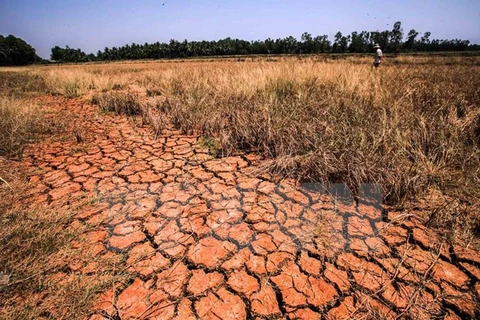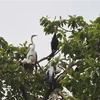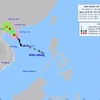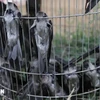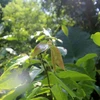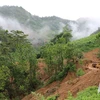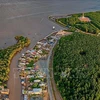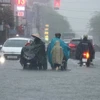 Many farmers who breed brackish-water shrimp in the Mekong Delta have cut back on production because of high salinity this year. (Photo: VNA)
Many farmers who breed brackish-water shrimp in the Mekong Delta have cut back on production because of high salinity this year. (Photo: VNA) HCM City (VNA) - Many farmers who breed brackish-water shrimp in the Mekong Delta have cut back on production because of high salinity this year.
Ly Thanh Dan, who has four ponds to breed shrimp in Bac Lieu Province’s Hoa Binh District, is now breeding shrimp in only one pond.
“I have stored water with low salinity since the last rainy season, but the water is only sufficient for breeding shrimp in one pond,” Dan said. “Shrimp will grow very slowly in water with a high level of salinity.”
The industrial shrimp area in Bac Lieu covers about 2,500ha, accounting for less than 15 percent of the province’s total area devoted to shrimp breeding, according to the province’s Aquaculture Sub-department.
Pham Hoang Son, head of the province’s Aquaculture Sub-department, said the salinity is expected to continue to be high in the coming time.
“We have warned farmers not to breed a new shrimp crop until the beginning of the rainy season,” he said.
Saline intrusion has entered up to 70km deep inland on rivers in many areas in the delta.
In most provinces that breed brackish water shrimp, farmers have reduced the cultivation areas by 50 percent because of high salinity, according to the Ministry of Agriculture and Rural Development’s (MARD) Aquaculture Department.
In Soc Trang, Ca Mau, Bac Lieu and Kien Giang provinces, salinity has exceeded 30 gram per litre. When the salinity is above 30 gram per litre, shrimp are easily affected by disease.
Le Van Su, director of the Ca Mau Province Department of Agriculture and Rural Development, said hot weather has affected not only industrial and semi-industrial shrimp farming areas but also extensive shrimp farming areas.
In Ca Mau Province, which has the country’s largest shrimp cultivation area, more than 2,678 ha of extensive shrimp farming areas have been affected by disease with a damage of 30-70 percent so far this year, up 1,864 ha against the same period last year.
Solutions
The MARD’s Animal Health Department has told provinces to increase environmental surveillance to promptly warn farmers about major changes in salinity and other environmental factors.
Provinces should instruct farmers about safe breeding techniques, focusing on factors that cause disease like salinity, temperature and water depth in ponds, said the Animal Health Department.
Farmers should follow relevant agencies’ warnings and schedules when breeding shrimp, it said.
Vu Van Tam, MARD Deputy Minister, has required that MARD’s Animal Health Department set up a national programme to prevent and control diseases on brackish water shrimp, considered to be one of Vietnam’s most important aquaculture species.
The country exports about 3 billion USD worth of brackish water shrimp a year.
The delta’s natural conditions are suitable for breeding this kind of shrimp, accounting for 80 percent of the country’s brackish water shrimp output.
Shrimp-rice cultivation has expanded in the delta’s coastal provinces, reaching 160,000 ha, according to the MARD’s Directorate of Fishery.-VNA

